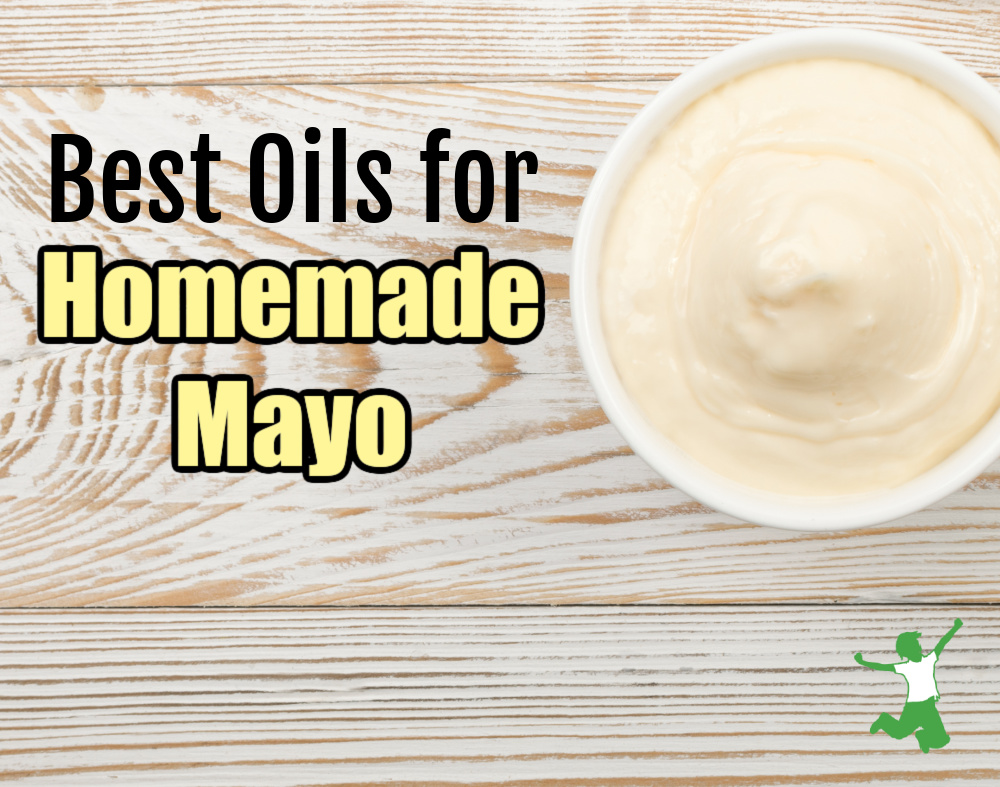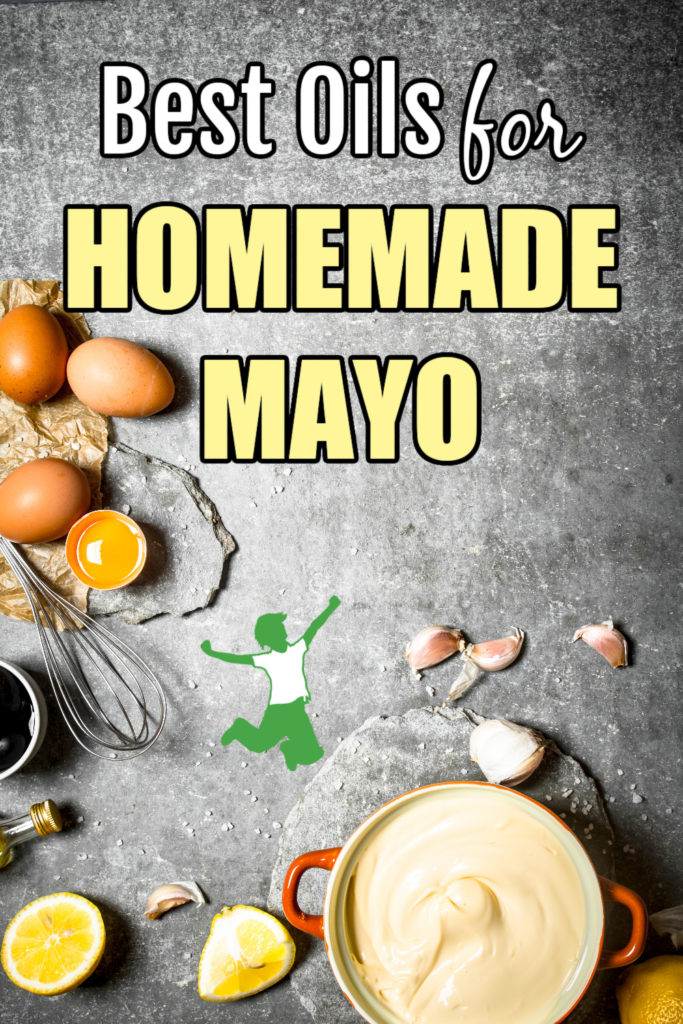Table of Contents[Hide][Show]
Which oils to consider for making nourishing homemade mayonnaise and which is best based on taste, consistency and healthy fat content.

Life without mayonnaise? Perish the thought! It is an essential condiment in the kitchen and learning how to make healthy mayo yourself is so simple and easy that once you give it a go, you won’t be settling for anything from the store – including the healthfood store – ever again!
Even homemade eggless mayo is super simple to whip up yourself. Psst. Don’t use aquafaba though!
The smooth, creamy texture and sheer elegance that quality mayo imparts to sandwiches, salads, and sauces are certainly unrivaled at least in American cuisine.
Never does the thought cross my mind to “go light on the mayo”. If I am feeling like a huge dollop or two, I feel free to indulge myself given that the mayo I insist on using is of superior freshness and quality and made with health-boosting oils and liquid whey for additional digestive enzymes and even probiotics.
Given that the fats used in the mayo are the most critical ingredient, which oils are the best ones to select?
Sunflower or Sesame?
I tell folks that when making mayo for the first time, use sunflower seed oil as this will give the closest consistency and taste to store mayo.
However, sunflower oil is a high omega-6 oil. This is fine if one follows whole food, traditionally based diet where the omega 3 to omega 6 fatty acid ratio is roughly between 1:1 and 1:4.
If one is still in the process of transitioning off processed foods, however, a lower omega-6 oil is probably a better choice. This is because processed foods are loaded with rancid omega-6 oils. Too much in your diet encourages inflammation.
Note that including even a few processed foods in the diet can skew that omega-3 to omega-6 balance in a hurry!
If you are concerned about your omega-6 intake, unrefined sesame oil is a good choice for mayo as it is higher in oleic acid (monounsaturated, omega 9 fat) and lower in omega-6 fats (polyunsaturated) than sunflower oil. Oleic acid is the healthy fat found in great quantity in avocados and olive oil.
Olive Oil
If oleic acid is so fantastic, then why not just use extra virgin olive oil for mayo?
While this can be a good choice for some, many folks find the flavor of olive oil mayonnaise too strong.
Using half olive oil and half sesame oil is an option for a milder taste which is still high in oleic acid.
In addition, some folks find that olive oil really packs the weight.
Oleic acid is a long-chain fatty acid and is more likely to contribute to the buildup of body fat than shorter chain fatty acids found in coconut oil or ghee. Let’s talk about both of those next.
Coconut Oil or Ghee
What about ghee or coconut oil for mayonnaise?
I’ve made mayo with ghee before and it turns out absolutely fabulous. The one drawback is that the mayo turns out too rich in my opinion. It also hardens in the refrigerator and loses consistency when brought to room temperature.
Since I like to use a lot of mayo, using all ghee doesn’t really work for me in most situations. However, half ghee and half sesame oil can work to lighten up the richness factor a bit.
A similar problem happens with coconut oil mayo. It hardens in the fridge and can’t be used quickly for chicken salad and other dishes.
If you choose to make coconut oil mayonnaise, be sure to use expeller-pressed, which is flavorless. Virgin coconut oil results in a coconut flavored mayo, which some people do not enjoy.
Blended Oils
Another option for homemade mayo is to blend fats together to achieve a good taste and consistency.
One I’ve used in the past is 1/2 sunflower or sesame oil and 1/2 expeller pressed coconut oil.
Since coconut oil goes very firm below 76 F/24 C, using half expeller-pressed coconut oil produces a mayo that is very thick and scoopable even after refrigeration.
Another option suggested by the Weston Price Foundation is what’s known as “Mary’s Blend” after the late Dr. Mary Enig, a PhD in lipids. She suggested a blend of 1/3 olive oil, 1/3 sesame oil, and 1/3 coconut oil.
Avocado Oil. My Favorite Fat for Mayo
As you can see, there are numerous options for healthy fats for making mayo.
Judging based on taste, nourishing lipid content, and consistency (both at room temperature and refrigerated), my favorite is avocado oil.
It is mild tasting, has a fatty acid profile similar to olive oil, and the mayo stays creamy in the fridge.
If you must buy, there are a couple of brands now available that are acceptable. This is the brand I use in a pinch. The only downside is that it does not use raw egg yolks, and it is a bit pricey.
Be sure to check my Resources page for a list of brands I trust that supply quality oils for all your mayo-making endeavors!
Here’s a short video of what avocado oil mayo looks like after I made a batch.









true…if you have a diet high in omega 3, one would be okay to use it, right?
BTW, the image in the Tropical Traditions link is NOT the image of the product in question. I don’t know why that one comes up.
Sarah, I was hoping to avoid having to buy expeller coconut oil and make do with the coconut products I already have on hand, thus, the question about the coconut palm shortening. Sorry, I think I said “palm oil” the first time; I meant organic palm shortening. I’m wondering if it’s healthy; it appears to be, and I’m hoping I can use it for mayo as it has no coconut flavor. I love it for frying eggs and oiling baking dishes. Do you have any experience with this product? Here is the Tropical Traditions link to the shortening. http://www.tropicaltraditions.com/organic_palm_shortening.htm Thanks!
Grapeseed is still very high in omega 6 fats even if you find a brand that doesn’t use solvents. So it would be like sunflower oil .. just passable but not ideal.
ah, some brands use hexane, etc, some do not – the spectrum brand does not and uses no other solvents!
Deb- I have used palm oil before for mayo and it makes a great creamy neutral one! I have also done lots of combinations of olive oil and coconut oil together and that works great! Your palate will eventually learn to love the taste of olive oil in mayo you just need to find an olive oil you like! I have also made it with bacon fat that is a great mayo as well! Keep experimenting
I made home made mayo this week using a light olive oil and coconut oil 50:50 ratio. I also used apple cider vinegar (with the mother in it) and whey. Next time I’ll try sesame or safflower. I think I’m also going to add some roasted garlic to boost the flavor. I absolutely love it!!
Coconut oil!
really? that is not what my chiropractors said…i will have to ask them about that….
Hi Sarah,
I have been experimenting with homemade mayo a lot lately, in addition to looking into what other people put in theirs. I read a suggestion from someone to use peanut oil, but I’m not sure if this is a good healthy oil to use (I would most likely cut it with EVOO or try some ghee!). The mayo they made looked fantastically thick and creamy. Mine is usually a bit thin… 🙁
We follow a very strict diet when it comes to our oils (coconut oil, lard, EVOO, butter from grassfed cows, and absolutely never touch the other so called “healthy oils” (soy bean, canola, etc..) and I want to stay as faithful as possible to the healthiest of oils, but I must admit..I really do not like a straight EVOO mayo..
Anyway, your take on peanut oil would be greatly appreciated! I find your blog so helpful and you really know your stuff!
Hi Julia, peanut oil is ok – it is high in monounsaturated fats like olive oil but I would suggest sesame instead. Peanuts can be moldy unless grown in a very dry climate and the oil might be questionable quality wise. Try half sesame and half expeller coconut oil. I think you might really like it.
Good idea with the coconut oil. I don’t know why I never thought of that! I might even try it with the flavor coconut oil for a twist. Too bad I just made some today. I will have to wait a week to make!